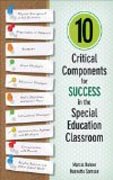
10 Critical Components for Success in the Special Education Classroom
Rohrer, Marcia W.
Samson, Nannette M. (Marie)
Your blueprint for building structure, consistency, and accountability year-round! This must-have guide provides special education teachers with a solid, workable action plan to manage the classroom and ensure student success. Learn instructional strategies to: Support all students with special needs, including those with more severe disabilities Organize your classroom, materials, and staff and student schedules Plan and assess standards-based lessons, annual IEP’s, behavioral interventions, and more Foster parent communication and staff collaboration Packed with real-world examples, free tools to use and share, a list of resources and a helpful glossary, this dynamic resource will inspire you, develop your teacher toolbox, and ensure your students are on the path to achievement! INDICE: PrefaceAcknowledgmentsAbout the AuthorsIntroduction1. Physical Arrangement of the Classroom Rationale Benefits of a Well-Designed Classroom Well-Defined Areas Clarify Student Expectations The 10-Minute Rule Arranging Your Classroom Required Areas Home Base Group Instruction Area Teacher Work Area Transition Area Student Schedule Area Work Station Technology Area Additional Areas Arts and Crafts, Eating, and Cooking Areas Personal Hygiene Sensory Area Recreation and Leisure Activity Area Getting Started Summary Real-Life Applications2. Organization of Materials Rationale Organizing Classroom Materials What supplies will you need? What stays and what goes? Where will materials be located? Group by academic subject Group by frequency of use Safety considerations Organizing Student’s Materials Summary Real Life Applications3. Schedules Rationale The Three Types of Schedules Building a Foundation for Your Schedules Daily Classroom Schedule Creating Your Classroom Schedule Posting the Classroom Schedule Using the Daily Classroom Schedule Staff Assignment Schedule Individual Student Schedules The Importance of Symbolic Communication Forms Creating Student Schedules Student Schedule Formats and Locations Teaching Students to Use Schedules Summary Real-Life Applications4. Visual Strategies Rationale What Are Visual Strategies? The Importance and Benefits of Visual Strategies Creating Visual Strategies Consider the Student's Communication Level Using Visual Strategies As Reminders Schedules Calendars Behavioral Cues Communication Supports Summary Real-Life Expectations5. Behavioral Strategies Rationale Determing the Need for Behavioral Inteventions Conducting a Functional Behavior Assessment Define the Behavior Gather Information About the Behavior Review Records Conduct Interviews Collect Baseline Data Look for Patterns of Behavior Make a Hypothesis about the Function of the Behavior Identifying Behavioral Goals and Objectives Developing a Behavioral Intevention Plan Defining Consequences Meaningful Reinforcers Edibles as Reinforcers Nonedibles as Reinforcers Punishment Strategies to Change Behavior Implementing the Behavioral Intervention Plan Summary Real-Life Applications6. Goals, Objectives, and Lesson Plans Rationale Legal Foundation Annual Goals and Objectives Develop a Present Level of Academic Achievement The Need for Data Collection Methods for Collecting Data Special Factors and the Individualized Education Program Write the Annual Goals and Objectives Lesson Plans Lesson Plan Elements Monitoring Student Progress: Your Grading System Summary Real-Life Applications7. Instructional Strategies Rationale Instructional Considerations Age-Appropriate Materials and Activities Variety Increases Interest Sensory Needs Instructional Methods and Strategies Direct Instruction Applied Behavior Analysis Grouping Students Social Stories Having a Substitute Teacher Work Stations Station Rotation Community-Based Instruction Summary Real-Life Applications8. Communication Systems and Strategies Rationale The Speech and Language Pathologist Communication Throughout the Day Teaching Social Skills The Use of Schedules and Communication Communication and Assistive Technology Communication and Behavior Summary Real-Life Applications9. Communication with Parents Rationale Setting Up a System for Parent Communication Student-Generated Daily Communication to Parents Keeping Communication Meaningful and Helpful Documentation Parental Involvement Summary Real-Life Applications10. Related Services and Other School Staff Rationale Important Information About Related Services Related Services Defined Who Qualifies for Related Services? Direct Versus Indirect Services Service Delivery Models Other School Staff Summary Real-Life ApplicationsPutting It All TogetherResourcesGlossary and Acronym GuideFormsIndex
- ISBN: 978-1-4833-3916-0
- Editorial: Corwin
- Encuadernacion: Rústica
- Páginas: 232
- Fecha Publicación: 31/05/2014
- Nº Volúmenes: 1
- Idioma:
